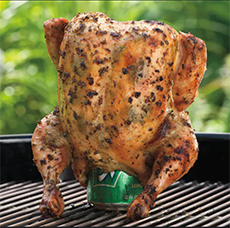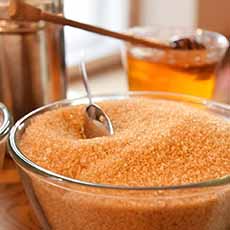Wine Can Chicken Recipe, For The Grill Or Oven
|
The second Saturday of June (tomorrow) is National Rosé Day. For some serious eating and some food fun, how about Rosé Can Chicken? Here’s a more elegant version of Beer Can Chicken from D’Artagnan, purveyor of fine foods (photo #1). The sauce is made with a glass of rosé. Why put a chicken over a can of beer or wine? Roasting a chicken vertically, whether in the oven or barbecue, will yield crisper skin and juicier flesh. Standing up, the grease drippings run clean off the body into the pan below. The result is crispy skin. And the technique is also a conversation piece. The beer flavor doesn’t imbue the flesh, so much as it provides the moisture of evaporation to make the flesh more succulent. While it contributes no alcohol to the chicken, if you don’t want to use alcohol, fill an empty can with cider or stock, or use a can of soda (photo #3). The history of Beer Can Chicken is below. Here’s an explanation of the claims for moister chicken. The difference with this recipe is, instead of a beer can and a side of barbecue sauce, rosé, pan drippings and crème fraîche come together for a simple, silky sauce. Chicken Note: D’Artagnan made the dish with their proprietary Green Circle chicken (photo #2), a free-range chicken, certified humane by Humane Farm Animal Care, raised without antibiotics or hormones. They’re fed actual vegetables collected from commercial kitchens and farmers markets, along with grains. The diet and the care that is taken on the farm—plus air-chilling—give these birds a unique, old-fashioned, real chicken flavor. Of course, you can use your bird of choice. Wine Note: If you can’t find canned rosé (photo #6), you can use any canned white wine or sparkling white wine. If you need a hack, fill an empty can of beer with the wine. And, buy enough rosé to drink with the chicken (photo #7). For a side, we like a mixed green salad with cherry tomatoes and a Dijon vinaigrette. Preparation 1. REMOVE the chicken from the refrigerator about 40 minutes before cooking, to take the chill off. Preheat the oven or a grill to 425°F. 2. CREATE a spice rub by stirring together in a small bowl the herbes de Provence, salt, honey granules, garlic powder, fennel pollen, smoked paprika, and pepper. 3. PAT the chicken dry inside and out with paper towels. Season the cavity with about a teaspoon of the spice rub then massage the rest of the rub all over the outside of the chicken, coating evenly. 4. POUR half of the rosé into a glass and set aside. Using a church key type can opener, make an additional hole in the top of the can, then place the can in the center of a cast-iron skillet and slide the chicken onto the can. Balance the legs of the chicken to steady it. Fold the wing tips back. 5. PLACE the pan in the oven or on the grill and roast until an instant-read thermometer inserted into the thickest part of the breast and thigh registers 155°F, about an hour. Note that vertically roasted chicken may reach temperature faster than traditional roasting, so start checking for doneness around 40 minutes. Also note that the temperature will continue to rise while the bird rests. If the chicken skin starts to get too dark too early, cover with foil until the last 10 minutes of cooking. 6. CAREFULLY REMOVE the pan from the oven or grill. Using heat-proof gloves, remove the chicken to a cutting board and rest it vertically for at least 15 minutes. Meanwhile… 7. MAKE the sauce. Drain the pan drippings into a fat separator; then return the juices to the pan or skim off the fat with a spoon. Place the pan over direct medium-high heat either on the stove top or grill. Add the reserved rosé, whisking up any browned bits (fond). Cook until the liquid has reduced by half, about 7-10 minutes. Then remove from the heat and whisk in the crème fraîche. Taste for seasoning, adding salt and/or pepper, if needed. 8. REMOVE the rested chicken from the can and carve. Serve with the sauce on the side. |
|
|
|
THE HISTORY OF BEER CAN CHICKEN Credit for popularizing Beer Can Chicken goes to Steven Raichlen, with publicity in The New York Times, the Today Show and other key media outlets. Raichlin, the author of The Barbecue Bible and other books, published the Beer Can-Chicken cookbook in 2002. But Beer Can Chicken actually burst on the barbecue scene around 1995, says Raichlin. “…while I didn’t invent it (I learned it from a Texas barbecue team called the Bryce Boar Blazers,” whom he met at the “Memphis in May” World Championship Barbecue Cooking Contest. “I did introduce it to the American mainstream [source 1] [source 2].”
|
||









